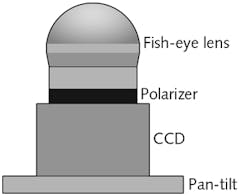Small skylight compass measures angular direction to 1° on cloudy days

While many of us might feel omnipotent holding our smartphones and using GPS to navigate here and there without much actual spatial awareness of our surroundings, that feeling of power quickly fades outside the range of cellphone coverage. Our lack of an internal compass is why hikers (unless they bring along a satellite GPS system) often carry a magnetic compass to help orient themselves with respect to the land and to their maps. Compasses are especially useful on uniformly cloudy days, when little or no visual directional clue is available from the sky.
Now, a group of researchers from North University of China (NUC; Shanxi, China) has come up with a way to use the light from a cloudy sky to find one's angular orientation to an accuracy of better than 1°. Because of differences in scattering of sunlight or moonlight across the sky, polarization can be used as an orientational aid—however, this is normally done under at least partially clear conditions. But polarization information can actually be measured even through a heavy layer of clouds. Knowing the sky position of the Sun (or, for clear skies, the Moon), the NUC polarimeter captures full-sky polarization images and derives the degree of polarization (DOP) and the angle of polarization (AOP), and from that calculates the standard compass direction with respect to north. The device has three CCD cameras, each coupled with a fish-eye lens and polarizer. The reference angles of the three polarizers are set at 0°, 45°, and 90°, and the resulting info is fed into a so-called pulse-coupled neural-network (PCNN) algorithm to derive angular orientation. Reference: J. Tang et al., Opt. Express (2016); http://dx.doi.org/10.1364/oe.24.015834.
About the Author
John Wallace
Senior Technical Editor (1998-2022)
John Wallace was with Laser Focus World for nearly 25 years, retiring in late June 2022. He obtained a bachelor's degree in mechanical engineering and physics at Rutgers University and a master's in optical engineering at the University of Rochester. Before becoming an editor, John worked as an engineer at RCA, Exxon, Eastman Kodak, and GCA Corporation.
